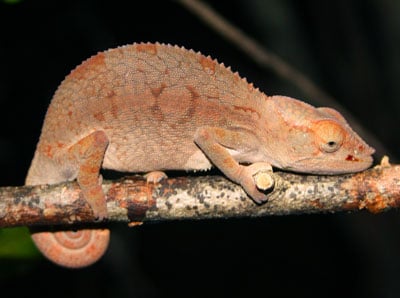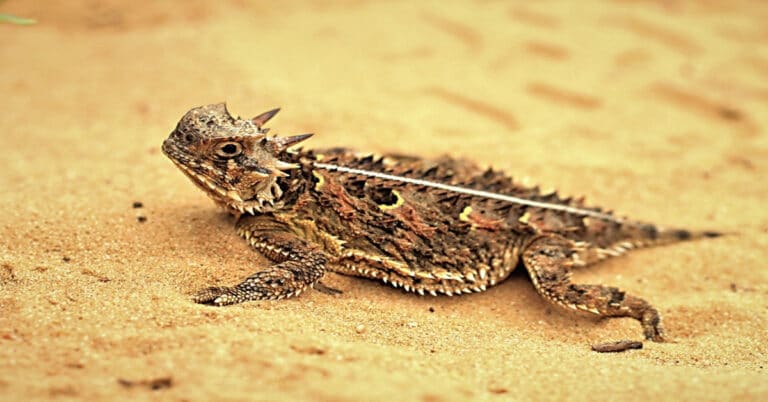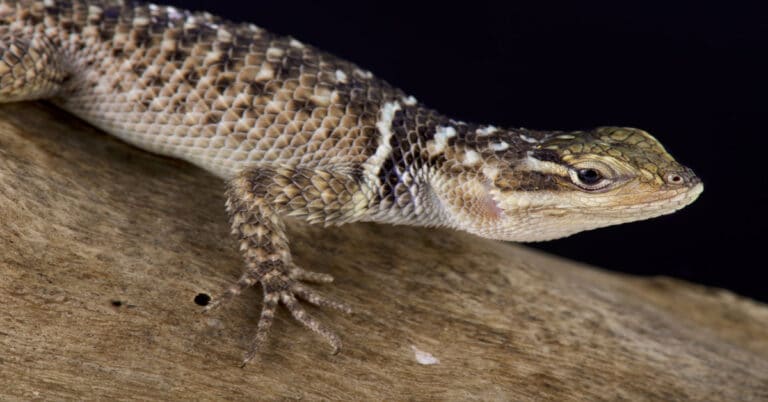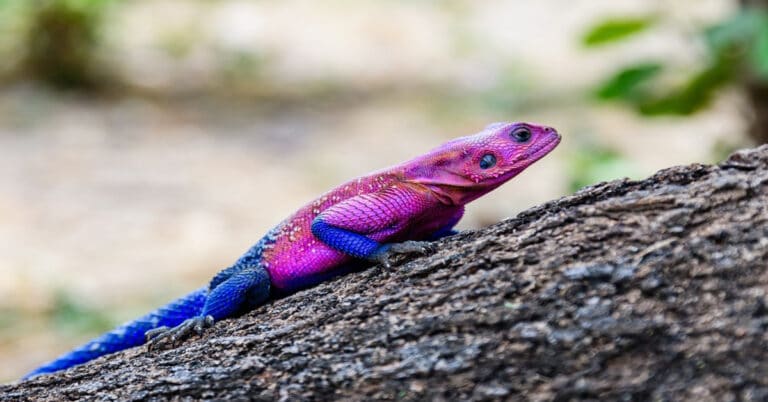Chameleon Lizard
Scientific Classification
| Kingdom: | Animalia |
| Phylum: | Chordata |
| Class: | Reptilia |
| Order: | Squamata |
| Suborder: | Iguania |
| Infraorder: | Acrodonta |
| Family: | Chamaeleonidae |
Chameleons belong to the Chamaeleonidae family. They are highly specialized and quite distinctive. They belong to the lizard clade (belonging to one tree of life from an ancestral group). There are more or less, 160 chameleon species, They come in a wide assortment of colors. Many species of these lizards have the ability to alter their color. You can distinguish the Chameleons from other lizard species by their feet that are Zygodactylous (like a bird’s foot with the second and third toes forward and the first and fourth toes curving backward. They have stereoscopic, independently mobile eyes. They possess very long, highly adapted tongues which they can extrude quite swiftly. They sway when they walk. They sport distinctive crests on their heads, You can spot prehensile tails on some species. They are very agile climbers and very good at visual hunting. You can find them in warm environments that vary from tropical rain forests to desert-like areas, in Africa, Madagascar, southern Europe, and southeast Asia, extending to Sri Lanka. Now you can find them in Hawaii, Florida, and California.

Etymology
“Chameleon” derives from the Latin word “chamaelo”
Classification
Chamaeleonidae family initially had two sub-families: Brookesiinae and Chamaeleoninae.
The validity of this sub-division evoked a great debate, Phylogenetic studies point out that pygmy chameleons which are part of the subfamily Brookesiinae are not monophyletic (they share derived features and are part of an ancestral tree). They are not the progeny of one ancestor. The authorities have given up this sub-family segregation and no longer identify any subfamilies within the family Chamaeleonidae.

Change of color
The common chameleon (Chamaeleo chamaeleon) changed into black color when threatened
The Namaqua chameleon in a threatening display turned black and opened its mouth when the authorities tried to move it off a busy road near the Namib-Naukluft National Park.
Many chameleon species can alter their skin coloration. Different species can change their coloration and patterns, making use of astute combinations of red, pink, orange, blue, purple, black, green, brown, turquoise, light blue, and yellow.
Change of coloration in chameleons serves many functions. The change of color helps in social signaling and also to exhibit reactions to temperature and other conditions. It also helps in camouflage. The comparative importance of these functions changes according to the species as well as the environment.. Color change signals a chameleon’s body condition and intentions to fellow chameleons. Chameleons change to darker colors when angered, or attempting to frighten or threaten others. Some males exhibit many colored patterns when wooing females.
A few species, like Smith’s dwarf chameleon, alter their color for camouflage in tune with the vision of the particular predators (bird or snake) which threaten them.
The Namaqua chameleon, which lives in the desert also uses color change to aid thermoregulation, turning black in the cool mornings to absorb heat more effectively. It takes on a lighter gray color to reflect light during the day’s heat. It even shows both colors at the same time, neatly segregated on either side of the spine.
Anatomy

Chameleons are a very typical and well-known lizard species, because of the large expressive eyes and curled tail. They say there are more than 160 distinct species of chameleons that vary in size from just an inch to more than two feet. You can find the very small pygmy chameleon in the Madagascar jungles. Among the The smallest chameleon species, some males measure less than 3 cm in length.
It is quite interesting to note that the largest chameleon species, the Malagasy giant is also native to the Madagascar jungles. They grow to nearly 70 cm long. . Parson’s chameleon, (We can also find them in Madagascar) can reach a length of about 65 cm.
The chameleon, even though it is a reptile, has extraordinary eyesight. The chameleon’s eye with its peculiar structure, enables the animal to have perfect 360 degree vision, surrounding its body. The special adaptation, enables the chameleon to observe prey and look out for predators more efficiently.
Habitat
You can find chameleons in jungle and deserts. They are omnipresent, whether it is Africa, parts of Southern Europe or Asia. People have introduced chameleons to parts of North America.
Diet
The Chameleon is omnivorous. They will eat anything. Some species of chameleon seem more carnivorous. Other species of chameleons opt for vegetarianism. The chameleon is not particular about what it eats. The diet usually includes berries, fruits, leaves, worms, snails and insects. The larger chameleons will even hunt and devour small reptiles.
Predators That Target Chameleons
Because of the small size of the chameleon, they become easy targets for ravenous predators. Snakes and birds that are the other tree dwelling animals, are the most common predators of the chameleon, as well as some mammals.
Breeding

Female chameleons at first digs holes in the forest floor (anything from 10 to 30 cm deep) to bury their eggs to keep them secure and warm. The hole depth mostly depends on the species of the chameleon.
The female deposits a clutch of about 20 eggs. The number of the eggs can, in fact, vary from just one to even nearly 100. The eggs take around 4 to 12 months to hatch, depending on the species of the chameleon
Status
Today a number of chameleon species face the threat of extinction. We consider many other chameleon species as endangered. Pollution and deforestation cause habitat changes that contribute to declining chameleon’s numbers.
Chameleon as a Pet
Chameleons are wonderful animals. The experts on chameleon lizard care say that sometimes you may not find them as the best choice as pets. They are certainly not for the beginner and their needs are quite clear. They stress easily. They do not like people handling them. If you want to handle your reptile, pass the chameleon by.
People do keep several of the species as pets. The most common among lizard is the panther chameleon and the veiled Jacksons. Veiled chameleons are comparatively large. They grow up to 2 feet long, and so require a suitable large enclosure. They are fairly robust. Jackson’s chameleons are much smaller and need only less space. The males look like little tops with 3 horns on the head, but they are not very robust. Panther chameleons happen to be quite big. Males are much bigger than the females and display some remarkable colors.
Fun Facts about Chameleons
Chameleons’ Tongue and Eyes
Chameleons’ Tongue:
The tongues of the chameleons account to about 1 ½ their body length. This is like a 6-foot tall person having a 9-foot tongue!
The sticky tip their long tongues enables them to catch their prey (insects). They can shoot their tongues out and catch the insect in a fraction of a second.
Chameleons’ Eyes
Chameleons can rotate each eye independently in different directions.

Having discovered a fondness for insects while pursuing her degree in Biology, Randi Jones was quite bugged to know that people usually dismissed these little creatures as “creepy-crawlies”.







